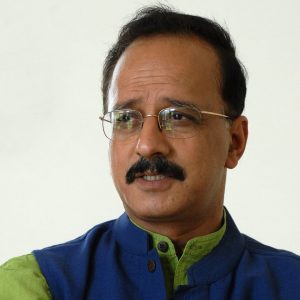There is a need to look beyond crop productivity, contract farming and privatization of markets and provide farmers with an assured income package every month, writes Devinder Sharma, a food and agri policy expert

Devinder Sharma – a food and agri policy expert
At a time when doubling farmer’s income in the next five years has become a catch phrase, I find the Niti Ayog, NABARD, Agricultural Universities, Research institutes, public sector units, and everyone even remotely concerned with agriculture now talking about ways to double farmers’ income. While the number of seminars on doubling the farmers’ income has also doubled in the past few months, farmers are increasingly sinking into a cycle of deprivation. Two years after a back-to-back drought, Demonetization has further reduced the farmers’ income, with estimates suggesting 50 to 70 per cent drop in farm incomes especially that of vegetable growers.
Interestingly in all the debates and discussions that I have participated in, there is nothing new emerging. The arguments invariably revolve around the same principles — increasing crop productivity, expanding irrigation, crop insurance and strengthening the electronic national agricultural market platform (e-NAM). What is more surprising is that those who talk of allowing markets to provide higher farm incomes are the ones who get assured salary packets every month. In addition, every six months, they get Dearness Allowance (DA), which has now been merged with the basic pay.
In India, only 1.3 per cent of the population is salaried, including the private sector. Against this, more than 52 per cent of the population, roughly 60-crore, comprises of farmers. The minimum wages these employees get are computed as per the recommendations of the Indian Labour Conference, 1957. Accordingly, the minimum wage should be based on the minimum human needs, for which a set of norms have been laid out: 1) three consumption units for one earner in a standard working family, with the earnings of woman, children and adolescent in the family being disregarded. 2) Net intake of 2,700 calories for an average Indian adult of moderate activity. 3) Per capita consumption of cloth of 18 yards per annum, which would mean for an average workers family of 4 a total of 72 yards. 4) Rent corresponding to the minimum area provided for under the subsidized industrial housing scheme for low income groups. 5) Fuel, lighting and other miscellaneous items of expenditure to constitute 20 per cent of the total minimum wage.
Subsequently, in an order issued by the Supreme Court in 1991, it laid out a set of six criteria for working out a minimum wage: children’s education, medical requirement, minimum recreation including festivals, ceremonies, provision for old age and marriage, should constitute 25 per cent of the wage. Further, it stipulated the minimum wage to include a dearness allowance compensating for inflation.
In other words, these criteria actually provides for a minimum monthly salary required by a family for a decent and honourable living. But strangely I find the same criteria that provide assured income to economists, scientists and planners is something they completely ignore when they talk of doubling farmers’ income. This smacks of double standards, protecting their own salaries while leaving the majority population to face the vagaries of markets. Ask the farmers who threw tonnes of tomatoes onto the streets recently in Chhattisgarh, and that too despite a bumper harvest, as to what the tyranny of market entails. Ask the families of those sugarcane farmers who committed suicide in Karnataka/Uttar Pradesh waiting for months for cane arrear payment as to what markets are all about.
It is primarily to address the extreme levels of inequality that prevails, and which is perpetuated by an economic design and has nothing to do with crop productivity, for several years now I have been asking for a separate farmers’ income commission that provides an assured take home income package to farmers every month. If crop productivity is the reason for farm crisis I see no reason why Punjab farmers should be committing suicide in big numbers. With a productivity level of 45 quintals per hectare of wheat and 60 quintals per hectare of rice, Punjab tops the global chart. And despite having 98 per cent assured irrigation, there is hardly a day when farmers don’t commit suicide.
So using the same criteria that the Supreme Court had laid down in 1991, and also following the same decent living norms prescribed by the Indian Labour Conference, 1957, a few of us – economists, researchers, and agricultural activists — came together for a workshop in Hyderabad in December to work out an income security model for farmers. This was followed by another workshop in Kerala – in which ten economists and policy researchers participated — in the first week of January to ascertain the payment that farmers deserve for the ecosystem services they protect while undertaking crop cultivation. Led by the United Nations, measuring ecosystem services is now becoming a global norm in computing what is called the green economy.
While farmers and many civil society organizations have been demanding the implementation of Swaminathan Committee report which proposed 50 per cent profit over the cost of production, what is not being realized is that since only 6 per cent farmers get the benefit of MSP, there is no mechanism to support the remaining 94 per cent farmers. My idea of providing farmers with an assured income package every month also includes the 94 per cent of the farming community who have been suffering silently all these years. MSP certainly will remain as one of the ways to provide a guaranteed income to farmers. But we have to work out other ways to provide assured income to rest of the farming community.
When the lowest government employees are ensured of a monthly pay of Rs 18,000 per month, and the non-agricultural workers with a daily wage of Rs 351, the state cannot ignore and leave food producers of the country with meager incomes that pushes them into a debt spiral forcing them to either leave farming or commit suicide. Our estimates based on the minimum prescribed living standards show that the farmers suffer a huge economic loss for providing cheaper food. The economic loss farmers suffer every year works out to 12-lakh crore. This is the huge price the farmers pay for subsidizing the nation by providing cheap food. In any case, using the internationally accepted norms for monetizing ecosystem services, farmers share in caring and protecting the environment and biodiversity justifies payment to the tune of Rs 14,000 per hectare.
This is a conservative estimate, and should form the basis for the entire deliberations the country is having on doubling farmer’s income. The time therefore has come to look beyond crop productivity, contract farming and privatization of marketing structures as the way forward to double farmer’s income. Unfortunately, economists have mistaken public and private sector investment in farming as income generation.
(The writer can be reached at his blog “Ground Reality”)




